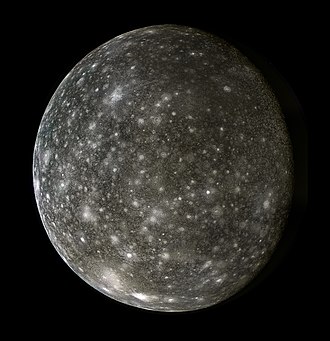Callisto (moon)

Callisto is one of Jupiter's largest moons and is the third-largest moon in the Solar System. It was discovered in 1610 by Galileo Galilei, along with the other Galilean moons: Io, Europa, and Ganymede. Callisto is named after a nymph in Greek mythology who was associated with Artemis, the goddess of the hunt. The moon has a diameter of about 4,821 kilometers, making it almost the same size as the planet Mercury.
Composition and Surface[edit]
Callisto's surface is heavily cratered and is considered one of the most heavily cratered objects in the Solar System. This extensive cratering indicates that its surface is extremely old, dating back several billion years. Unlike other moons of Jupiter, Callisto shows no signs of significant geological activity, such as plate tectonics or volcanism, which suggests that it has been geologically inactive for much of its history.
The surface is made up of a mixture of rock and ice, with a possible subsurface ocean lying beneath. The presence of an ocean is suggested by measurements of Callisto's magnetic field by the Galileo spacecraft, which orbited Jupiter from 1995 to 2003. However, this subsurface ocean has not been directly observed.
Atmosphere and Magnetosphere[edit]
Callisto has a very thin atmosphere composed primarily of carbon dioxide, with traces of molecular oxygen. Its atmosphere is too thin to support human life or to have any significant weather patterns.
The moon also has a weak magnetosphere, which is likely induced by its interaction with Jupiter's powerful magnetic field. This interaction shields Callisto from some of the charged particles in Jupiter's magnetosphere, making it one of the safer places for potential human exploration in terms of radiation exposure among Jupiter's moons.
Exploration[edit]
Callisto has been explored by several spacecraft, including the Pioneer 10 and Pioneer 11 missions in the early 1970s, the Voyager 1 and Voyager 2 missions in the late 1970s, and more extensively by the Galileo spacecraft in the 1990s and early 2000s. These missions have provided a wealth of information about Callisto's surface, composition, and environment.
Future missions to the Jovian system may include further exploration of Callisto, particularly because its relatively low radiation levels compared to other moons of Jupiter make it an attractive target for potential robotic or human missions.
Potential for Life[edit]
While Callisto's surface conditions are harsh and unlikely to support life as we know it, the possibility of a subsurface ocean raises intriguing questions about the potential for life in its interior. However, without direct exploration of this subsurface environment, any discussion of life on Callisto remains speculative.
In Culture[edit]
Callisto has appeared in various works of science fiction and popular culture, often depicted as a remote, icy world on the frontier of human exploration in the Solar System.
Ad. Transform your life with W8MD's Budget GLP-1 injections from $75


W8MD offers a medical weight loss program to lose weight in Philadelphia. Our physician-supervised medical weight loss provides:
- Weight loss injections in NYC (generic and brand names):
- Zepbound / Mounjaro, Wegovy / Ozempic, Saxenda
- Most insurances accepted or discounted self-pay rates. We will obtain insurance prior authorizations if needed.
- Generic GLP1 weight loss injections from $75 for the starting dose.
- Also offer prescription weight loss medications including Phentermine, Qsymia, Diethylpropion, Contrave etc.
NYC weight loss doctor appointmentsNYC weight loss doctor appointments
Start your NYC weight loss journey today at our NYC medical weight loss and Philadelphia medical weight loss clinics.
- Call 718-946-5500 to lose weight in NYC or for medical weight loss in Philadelphia 215-676-2334.
- Tags:NYC medical weight loss, Philadelphia lose weight Zepbound NYC, Budget GLP1 weight loss injections, Wegovy Philadelphia, Wegovy NYC, Philadelphia medical weight loss, Brookly weight loss and Wegovy NYC
|
WikiMD's Wellness Encyclopedia |
| Let Food Be Thy Medicine Medicine Thy Food - Hippocrates |
Medical Disclaimer: WikiMD is not a substitute for professional medical advice. The information on WikiMD is provided as an information resource only, may be incorrect, outdated or misleading, and is not to be used or relied on for any diagnostic or treatment purposes. Please consult your health care provider before making any healthcare decisions or for guidance about a specific medical condition. WikiMD expressly disclaims responsibility, and shall have no liability, for any damages, loss, injury, or liability whatsoever suffered as a result of your reliance on the information contained in this site. By visiting this site you agree to the foregoing terms and conditions, which may from time to time be changed or supplemented by WikiMD. If you do not agree to the foregoing terms and conditions, you should not enter or use this site. See full disclaimer.
Credits:Most images are courtesy of Wikimedia commons, and templates, categories Wikipedia, licensed under CC BY SA or similar.
Translate this page: - East Asian
中文,
日本,
한국어,
South Asian
हिन्दी,
தமிழ்,
తెలుగు,
Urdu,
ಕನ್ನಡ,
Southeast Asian
Indonesian,
Vietnamese,
Thai,
မြန်မာဘာသာ,
বাংলা
European
español,
Deutsch,
français,
Greek,
português do Brasil,
polski,
română,
русский,
Nederlands,
norsk,
svenska,
suomi,
Italian
Middle Eastern & African
عربى,
Turkish,
Persian,
Hebrew,
Afrikaans,
isiZulu,
Kiswahili,
Other
Bulgarian,
Hungarian,
Czech,
Swedish,
മലയാളം,
मराठी,
ਪੰਜਾਬੀ,
ગુજરાતી,
Portuguese,
Ukrainian
